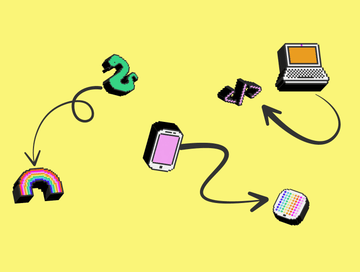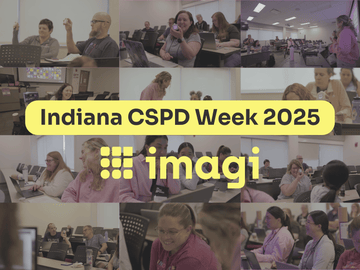
If you're a school, organization, or educator focusing on full-time computer science instruction, that's fantastic! We're thrilled to witness the increasing incorporation of computer science into permanent curricula across more educational settings. However, we understand that this isn't the reality for everyone. By offering flexible teaching content that can be broken down into smaller activities and lessons, we've ensured that the imagi curriculum and tools are accessible to all teachers, regardless of their coding or Python expertise, and irrespective of the time they can allocate to it.
Recognizing the importance of positive experiences with text-based coding for students, especially before high school, we've compiled a list of ways (along with their approximate time commitments) that educators can utilize imagi curriculum and resources to introduce Python in various educational environments, subjects, and units of study.
Time Commitment: 30 Minutes to 1 Hour
Are you looking to add to your stash of educational rainy day activities for when students are unable to go outside for recess? Or perhaps you're eager to introduce coding but finding it challenging to carve out the time? Look no further! We've curated a selection of beginner coding activities designed to guide students in their initial exploration of Python coding. From discovering how to generate their favorite colors using code, to programming their names or crafting secret messages to share with friends, or even showcasing their hobbies, these introductory activities are sure to become cherished STEM activities for the classroom.
Time Commitment: 1 Hour
If you're unable to dedicate an entire unit to teaching coding, Hour of Code provides thousands of free activities suitable for both independent exploration and teacher-led sessions, offering students an introduction to computer science. Specifically for Hour of Code, imagi provides a free Python crash course along with resources tailored for both students and teachers, enabling them to learn the art of creating stunning pixel art using Python.

Time Commitment: 2+ Hours
Coding challenges, such as imagi's "Coding Is Art Challenge" or “Entrepreneurship Challenge” provide students with opportunities to apply and showcase their creativity and innovation in coding. Schools worldwide participated in imagi's inaugural classroom coding challenge in October of 2023 with great success. These events serve as excellent opportunities for teachers to generate excitement around coding and demonstrate to students how Python skills can generate real-world impact and foster positive change through teamwork, creativity, and technology.

Time Commitment: 1 Hour to Full Day
Family-student coding workshops offer a fantastic opportunity not only to engage students in learning Python but also to involve the entire family, making them ideal for events like back-to-school nights or Family STEM Days. These events hold special significance as they enable family members and children to learn Python coding together, fostering stronger bonds and boosting confidence. This approach draws inspiration from a common practice among developers known as pair programming, where two programmers collaborate on a task and learn from each other. An organization called Girls Code Too, dedicated to encouraging girls to explore coding and pursue careers in tech, has achieved remarkable success by utilizing imagi to host their well-loved "mother-daughter" coding workshops held throughout the year.

Time Commitment: 1-2 Hours Per Week
Makerspaces serve as creative workshops where students can explore technology, engineering, and art through hands-on experimentation. Wendie Turner, a Media Technology Specialist, has utilized the makerspace at Stanton-Smith Elementary to introduce Python coding, particularly to girls, through an after-school club called the "Code Charmers," inspired by the engaging imagiCharm. This approach provides her students with the chance to delve into coding, unleash their creativity, and experiment within an informal and supportive community.
Time Commitment: 1-2 Hours Per Week
Educator and CS equity advocate Kelly Powers spearheaded a 7-week virtual coding camp utilizing imagi tools to instruct students in Python programming through pixel art. Despite the camp being virtual, Kelly effectively facilitated collaboration among peers in a playful, creative, and experimental manner using the imagi curriculum and platform, thereby enhancing the depth and significance of the learning experience. While students grasped coding concepts such as functions and for loops, the creative coding curriculum empowered them to apply their skills to code designs using Python that resonated with their interests - ranging from lightning bolts from Harry Potter to their favorite plushies.
Time Commitment: 1-2 Hours Per Week
Many nonprofit organizations have partnered with imagi to give students an opportunity to learn coding after school or outside of the traditional school day. Computer Science, Theater Arts and Performance Studies major from Brown University Navaiya Williams used imagi to teach programming after school with Black Girls Code. New to teaching Python, the lesson slides available in imagi Edu made it easy for her to prepare for the weekly lessons, guide instruction, and meet the needs of her students. imagiCharms served as a helpful check-for-understanding when teaching, as students could hold the Charms in the air, and Navaiya could immediately see who had mastered the concept or who needed more support.
Time Commitment: 1 Hour Daily for a Monthly Unit (Length of Unit Can Vary)
Wanting to introduce her students to the possibilities coding offers through different careers, middle school English teacher Danielle Hall decided to break from the traditional English curriculum to lead a Graphic Design unit in her classroom. Students began with researching different careers in the tech field, and ended the unit by learning real Python with imagi to create characters and designs with code. Danielle says introducing coding in her English classroom not only built students creativity and confidence, but it was also a great way to reinforce skills like checking their work and problem solving.
Time Commitment: 1+ Hours Daily for an Entire Unit (Length of Unit Can Vary)
Flipped classrooms, such as Techttoos Studios led by middle school technology teacher Brad Flickinger, revolutionize traditional approaches to STEM learning. In this approach, students watch and follow lessons at their own pace and subsequently apply their newfound knowledge through projects, earning badges instead of grades. This approach is ideal for educators aiming to individualize learning experiences and promote autonomy within the classroom. For Brad, utilizing the imagiCharm alongside the Python coding curriculum in this context enables him to observe student learning and progress in real-time, even as they engage in independent learning.

Time Commitment: 1+ Hour Daily for an Entire Unit (Length of Unit Can Vary)
Combining coding lessons with a research unit that spotlights underrepresented leaders in STEM offers a compelling way to bridge coding and technology with real-world careers, while also prompting children to critically examine why certain groups are often marginalized or excluded from STEM fields. Engineering and technology instructor Sarah Fortino's unit on "Black Women in STEM" at The Chestnut Hill School exemplifies how research projects can help students learn about the significant contributions of underrepresented groups to the technology sector. The unit serves as a mirror, reflecting some students' identities in these pioneering women, while also providing a window of insight for others. By combining a research project which was followed by Python instruction using imagi, students were better equipped to make tangible connections to the professional world and comprehend how their coding skills could pave the way for a future career.
We hope this diverse array of settings and approaches outlined here demonstrates the versatility of integrating Python coding using imagi into various educational contexts, catering to the needs of different teachers and students alike. From recess clubs to STEM research projects and beyond, imagi curriculum and tools offer accessible pathways for educators to introduce coding skills, fostering creativity, collaboration, and confidence among learners. Whether it's through virtual camps, afterschool clubs, or innovative classroom units, imagi is here to support you in empowering the next generation of coders.




